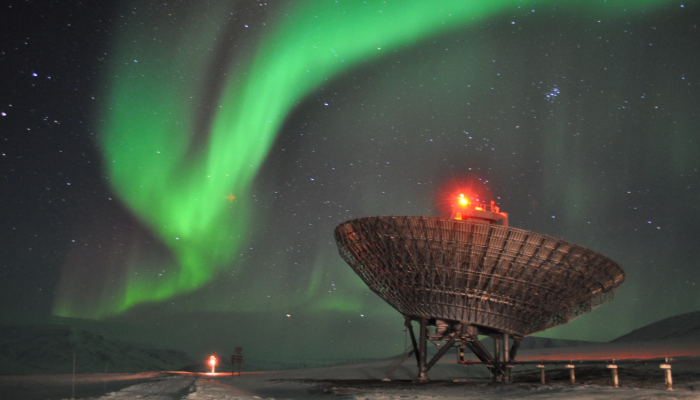
Recent research on the simultaneous displays of aurora in both hemispheres have lead to new knowledge of how large-scale asymmetries in the global magnetic field configuration can arise and be mitigated. This new understanding is contrary to what has been the consensus in the field, and was recently highlighted in a press release from the American Geophysical Union, followed by attention from numerous newspapers and magazines world wide.
These new results, published in a series of papers since 2015 [1,2,3,4,5,6], represents a paradigm shift in the explanation of the processes controlling how the magnetosphere twists around the Sun-Earth line. It has been known since the 1980’s that when the Interplanetary Magnetic Field (IMF) has a dawn-dusk component (By), the closed field lines inside the magnetosphere also develop a By in the same direction as the IMF. This has usually been explained by means of tail reconnection, a process that would allow field lines from each hemisphere to meet and produce new closed field lines, now being asymmetric. However, the new results show that the asymmetry of closed field lines, as highlighted by the aurora in one hemisphere being longitudinally displaced to its counterpart in the opposite hemisphere, start to emerge within 10 minutes. This is a much shorter response time than what can be explained by the the tail reconnection scenario. Furthermore, the highlighted studies also show that the process of tail reconnection actually act to reduce the longitudinal displacement of the northern and southern aurora. This is exactly opposite to the understanding that has been the consensus in the community, hence the importance of these results. In the AGU press release, editor-in-chief of JGR-Space Physics, Mike Liemohn, says: “This study explains both how asymmetries are created and how it is removed and it is exactly opposite of what I and many researchers have thought. Therefore, this result is kind of big deal.”
Director of the Birkeland Centre for Space Science and leader for the research group presenting the new findings, Nikolai Østgaard, says: “We are very satisfied with how the AGU Press Release turned out for us. As we speak, 104 newspapers and magazines worldwide has picked up the story. We could not have hoped for a wider impact among the public about our results.”
Along with the press release, the research group at the Birkeland Centre for Space Science prepared an animation of the processes leading to the longitudinal displacement of the aurora between the two hemispheres. This can be seen in the video below.
A more in-depth explanation of the mechanism can be seen in the video below where PhD candidate Anders Ohma, lead author of the JGR paper highlighted in the AGU press release, explains the physics behind the longitudinal displacement of the aurora between the two hemispheres.
[1] Tenfjord, P., Østgaard, N., Snekvik, K., Laundal, K. M., Reistad, J. P., Haaland, S., & Milan, S. E. (2015). How the IMF By induces a By component in the closed magnetosphere and how it leads to asymmetric currents and convection patterns in the two hemispheres. Journal of Geophysical Research: Space Physics, 120. https://doi.org/10.1002/2015JA021579
[2] Reistad, J. P., Østgaard, N., Tenfjord, P., Laundal, K. M., Snekvik, K., Haaland, S., … Grocott, A. (2016). Dynamic effects of restoring footpoint symmetry on closed magnetic field-lines. Journal of Geophysical Research: Space Physics, 121, 1–14. https://doi.org/10.1002/2015JA022058
[3] Tenfjord, P., Østgaard, N., Strangeway, R., Haaland, S., Snekvik, K., Laundal, K. M., … Milan, S. E. (2017). Magnetospheric response and reconfiguration times following IMF By reversals. Journal of Geophysical Research: Space Physics, 122(1), 417–431. https://doi.org/10.1002/2016JA023018
[4] Reistad, J. P., Østgaard, N., Laundal, K. M., Ohma, A., Snekvik, K., Tenfjord, P., … Haaland, S. E. (2018). Observations of asymmetries in ionospheric return flow during different levels of geomagnetic activity. Journal of Geophysical Research: Space Physics. https://doi.org/10.1029/2017JA025051
[5] Østgaard, N., Reistad, J. P., Tenfjord, P., Laundal, K. M., Rexer, T., Haaland, S. E., … Ohma, A. (2018). The asymmetric geospace as displayed during the geomagnetic storm on 17 August 2001. Annales Geophysicae, 36, 1577–1596. https://doi.org/10.5194/angeo-36-1577-2018
[6] Ohma, A., Østgaard, N., Reistad, J. P., Tenfjord, P., Laundal, K. M., Snekvik, K., … Fillingim, M. O. (2018). Evolution of Asymmetrically Displaced Footpoints During Substorms. Journal of Geophysical Research: Space Physics, 123. https://doi.org/10.1029/2018JA025869
